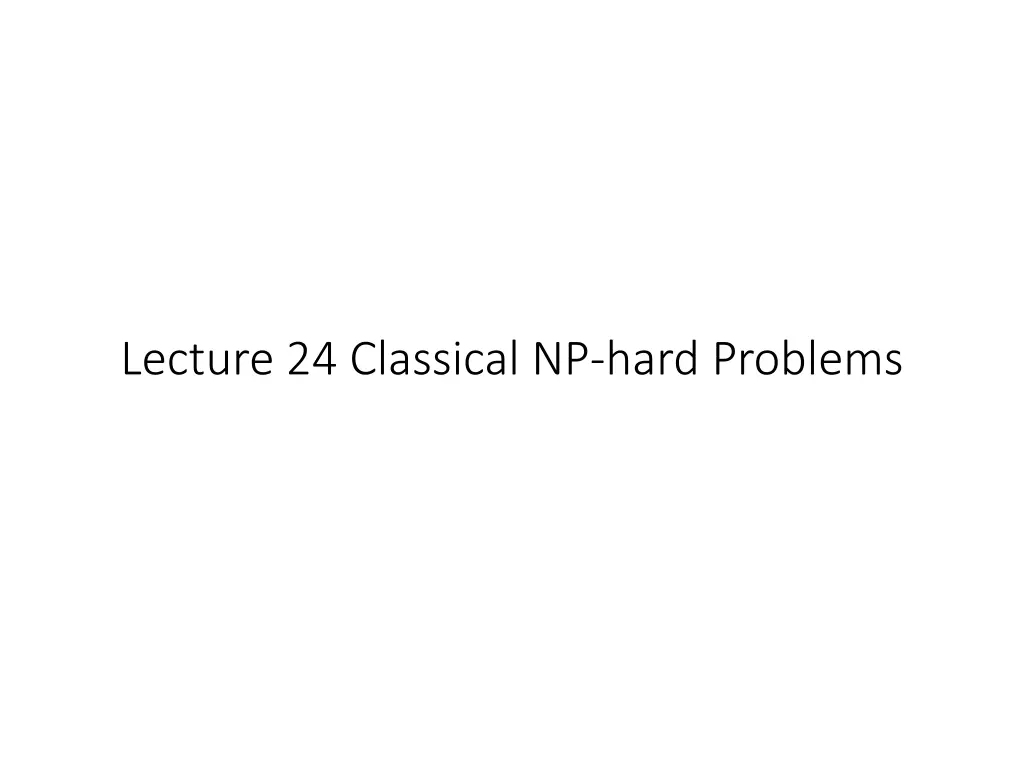
Understanding NP-Hard Problems and Reductions
Explore classical NP-hard problems like Hamiltonian Path, Traveling Salesman Problem, and 3-SAT with a focus on reductions to prove NP-hardness. Learn the general recipe for reductions and how to reduce one problem to another to establish complexity.
Uploaded on | 1 Views
Download Presentation

Please find below an Image/Link to download the presentation.
The content on the website is provided AS IS for your information and personal use only. It may not be sold, licensed, or shared on other websites without obtaining consent from the author. If you encounter any issues during the download, it is possible that the publisher has removed the file from their server.
You are allowed to download the files provided on this website for personal or commercial use, subject to the condition that they are used lawfully. All files are the property of their respective owners.
The content on the website is provided AS IS for your information and personal use only. It may not be sold, licensed, or shared on other websites without obtaining consent from the author.
E N D
Presentation Transcript
Outline Hamiltonian Path to TSP Cycle 3-SAT to Quadratic Program Tripartite Matching to SUBSET SUM
General Recipe for reductions In order to prove B is NP-hard, given that we know A is NP hard. Reduce A to B. What is a complete reduction? 1. Given an instance X of A, construct an instance Y of B. 2. 3. Prove that if answer to X is YES, answer to Y is also YES. Prove that if answer to X is NO, answer to Y is also NO. (Usually: prove the contrapositive: if answer to Y is YES, answer to X is also YES)
Hamiltonian Path Given a graph G, a starting vertex s and an ending vertex t. A Hamiltonian path from s to t is a path from s to t that visits every vertex in G exactly once. Hamiltonian Path problem asks if there exists a Hamiltonian path from s to t.
Travelling Salesman Problem Given a weighted graph G, a salesman wants to start at vertex s, visit all vertices in the graph, and then come back to s. Given a threshold L, TSP cycle problem asks whether there is a way to visit all vertices (and come back to s) with total edge length at most L. (Starting vertex does not matter, so s is not part of input)
Reduction from Hamiltonian Path to TSP cycle Step 1: Given an instance X of Hamiltonian Path, construct an instance Y of TSP cycle. Idea: Find similarities/differences of the problems. Similarities: visit every vertex in graph. Differences: 1. No weights in Hamiltonian Path 2. Path vs. cycle.
Outline Hamiltonian Path to TSP Cycle 3-SAT to Quadratic Program Tripartite Matching to SUBSET SUM
3-SAT Literals: A variable (?1), or the negation of a variable (?1). Clause: Logic OR of literals (?1 ?3 ?5) Conjunctive Normal Form: and of or s. ?1 ?3 ?5 ?2 ?3 ?4 ?1 ?4 ?5 3-SAT: Given a conjunctive normal form, where each clause contains at most 3 literals, decide whether there is a value of variables such that the formula is satisfied (A clause is satisfied if one of its literals is true; The formula is satisfied if ALL clauses are satisfied.)
Quadratic Programming Same as linear programming, except you are allowed to have quadratic constraints (e.g. x12+x2x3+ 3x4 3) Decision problem: Given a set of quadratic constraints, decide whether there is a feasible solution.
Reduction from 3-SAT to Quadratic Programming Step 1: Given an instance X of 3-SAT, construct an instance Y of Quadratic Programming. Two problems are very different, needs to use gadgets.
Gadget for variables Variable xi: either true or false Gadget: A variable in quadratic program that can only take two values (say 0 or 1) yi2= yi xi= true yi= 1; xi= false yi= 0 Negation of a variable: (1-yi)
Gadget for Clauses Clause: (?1 ?3 ?5) Interpretation: x1= true or x3= true or x5= false y1= 1 or y3= 1 or (1-y5) = 1 Can we write this as a constraint? y1+y3+(1-y5) 1
Outline Hamiltonian Path to TSP Cycle 3-SAT to Quadratic Program Tripartite Matching to SUBSET SUM
Tripartite Matching There are three sets of vertices U, V, W, each of size n. A hyper-edge is a 3-tuple (u,v,w) where u, v, w are vertices in U, V, W respectively. A tripartite matching is a way of selecting n hyper- edges, so that every vertex is adjacent to a hyper- edge. The decision version of the problem asks whether a tripartite matching exists.
SUBSET SUM/KNAPSACK In the SUBSET SUM problem, you are given n numbers a1, a2, , an, and a target m. The answer is YES if and only if there is a subset of these n numbers that sums up to m.
Reduction from Tripartite Matching to SUBSET SUM Step 1: Given an instance X of Tripartite Matching, construct an instance Y of SUBSET SUM. Similarity: Tripartite Matching wants to select hyper-edges, SUBSET SUM wants to select numbers. Question: how to map a hyper-edge to a number?
Idea: Use an intermediate problem SUBSET VECTORS Given n vectors v1, v2, , vn, and a target u. The answer is YES if and only if there is a subset of these n vectors that sums up to u. Reduce Tripartite Matching to SUBSET VECTORS Reduce SUBSET VECTORS to SUBSET SUM
